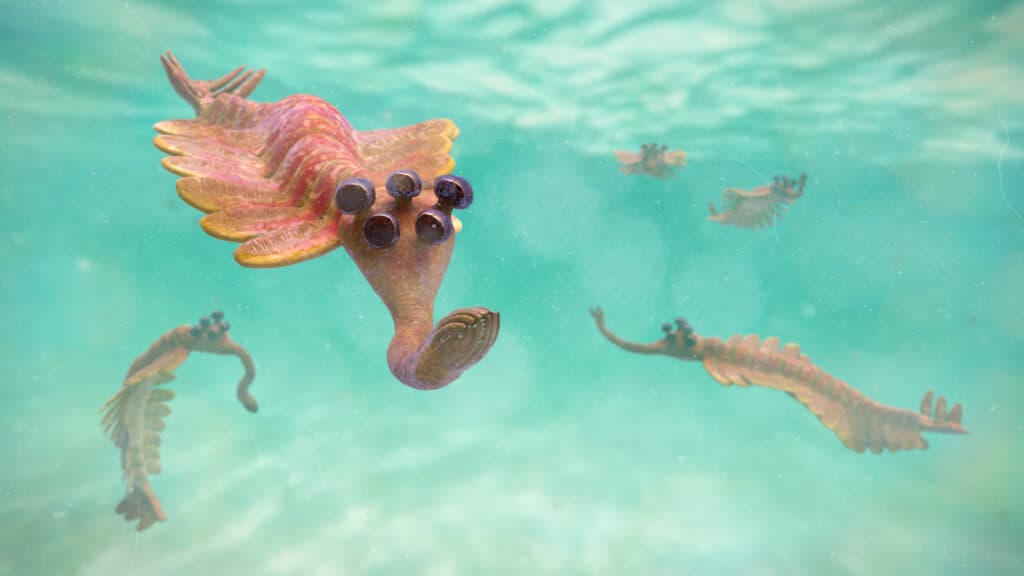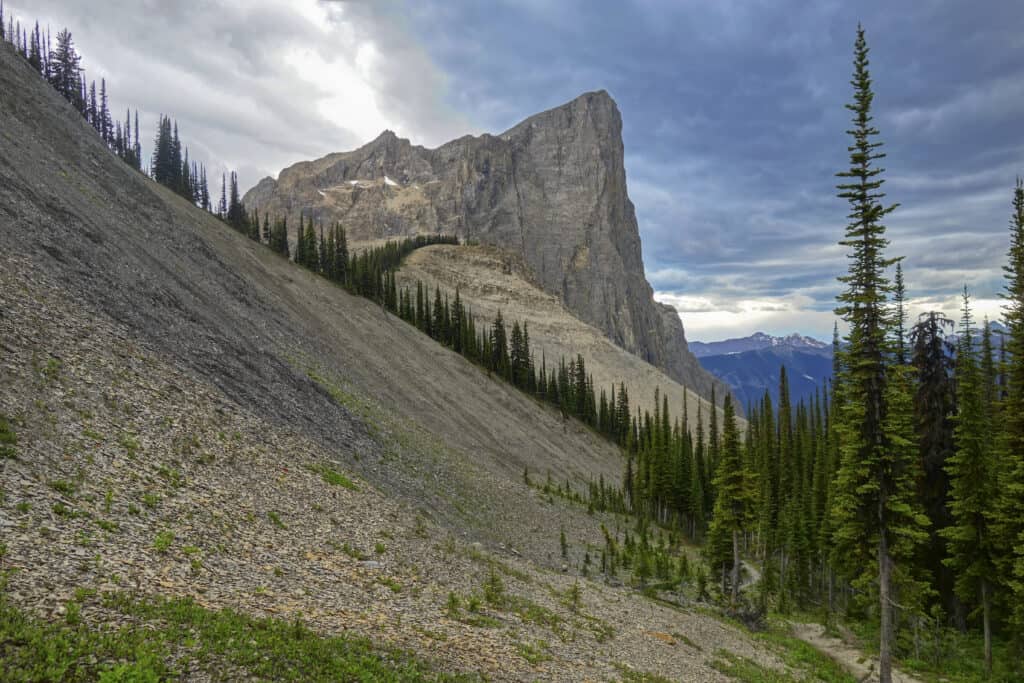Palentologist have dug up some pretty weird animals, but the Opabinia has to be one of the strangest prehistoric animals ever discovered. It is weird to imagine how an animal can possess five eyes on its head. Even for ancient animals this feature is quite unusual.
When it was first discovered, scientists found it difficult to place it in a specific phylum due to its many peculiar features. Sounds interesting, right? The creature looked so strange that the audience present when it was first presented, had to laugh.
Join us as we unveil everything you need to know about this bizarre animal with five eyes on its head.
Full Description and Size of Opabinia
An average size Opabinia had a length that ranged from about 1.6 inches to 2.8 inches, while the central part of its body was about 0.2 inches wide and possessed 15 segments. Each of these segments had pairs of lobes or flaps that pointed downwards and outwards. These lobes overlapped in such a way that the rear edge of each one covered the front of the one behind it.
One distinguishing feature of Opabinia is its hollow proboscis. The proboscis’ length was about 30% of its body and is usually pointed downwards from beneath its head. Just like the hose of a vacuum cleaner, the proboscis was marked and flexible. Towards the end of the proboscis was a claw-like structure with edges that had spines projected both inwards and outwards.
Speaking of the head of the Opabinia, it possessed five stalked eyes. This feature seems to be the fascinating thing about Opabinia. Two eyes are located towards the front of its head and point upwards and towards. The two larger eyes are located towards the outer edges of the head; they have longer stalks and are pointed upwards and sideways. The remaining eye pair is located between the giant eye pair and also points upwards. All the eye pairs are also assumed to be compound.
The mouth of the Opabinia is located beneath its head and behind the proboscis. The proboscis is long enough to get to its mouth. The mouth of the Opabinia points backward, making its digestive tract form a U-shaped bend moving towards the rear.

One distinguishing feature of Opabinia is its hollow proboscis, a tube-like structure it used to eat. It made up 30% of its total body.
©Dotted Yeti/Shutterstock.com
Origin of the Name “Opabinia“
The name, Opabinia (also known as Opabinia regalis) comes from the Opabin pass, located between Mount Hungabee and Mount Biddle along Lake O’Hara in British Columbia, Canada.
Diet- What Did Opabinia Eat?
The Opabinia is presumed to be carnivorous because the proboscis could have been used to search for food in the mud. Scientists believe that the Opabinia lived majorly near the seabed. It most likely fed on worms in the mud in crevices.
The claw-like proboscis containing spines on its end was very flexible and must have been used to sift through sediments in search of what to eat. When the Opabinia eventually catches its prey, it uses its long and flexible proboscis to pass the food to its mouth, usually facing backward.
The Opabinia didn’t possess jaws or teeth, which is why it is believed it only ate small and soft food items most of the time. They also possessed paired gut diverticula that could have helped in improving their food digestion efficiency, as well as good intake.
Habitat: When and Where Did the Opabinia Live?
The Opabinia is believed to have existed about 487 million to 505 million years ago during the Cambrian Period of the Paleozoic era. It must have lived near the Middle Cambrian Burgess Shale Lagerstätte of the British Columbia region of Canada.
Scientists also believe that based on habitat, the Opabinia was benthic, which means it likely lived on the sea bottom. Hence, it must have been a proficient swimmer. It possessed a tail fin with three lobes on both sides.
The wave motion of the lobes must have been responsible for its propulsion through the water. The fact that they mostly ate worms in crevices also suggests that they lived in water.
Threats and Predators of Opabinia
Whether higher predators threatened Opabinia isn’t known, but they were the predators instead. It was a sea bottom-feeding predator, also known as a detritivore. The primary mechanism for catching its prey was using its flexible proboscis to capture soft-bodied prey and organic materials. It is then passed to its mouth from there.
Discoveries and Fossils: Where Was the Opabinia Found?
The Opabinia fossils were discovered in 1912 by Charles Doolittle Walcott in the Burgess Shale. He discovered about nine almost complete Opabinia fossils. This discovery of a lifetime is why Charles Doolittle Walcott is often referred to as the father of Burgess Shale paleontology.
Aside from the fossils discovered by Charles Walcott, some other people also made later discoveries of Opabinia fossils in other regions. Harry Whittington discovered an Opabinia Specimen during his research between 1966 and 1967.
Whittington’s findings and analysis were later published in 1975, and they seemed to be very detailed. His analysis was detailed because the specimens were thoroughly dissected with photographs taken from different views and angles.
In 1960, a group of Russian paleontologists discovered Opabinia fossils in another region. The specimens were found around the Norilsky region of Siberia. However, Whittington didn’t welcome their findings because their fossils weren’t well preserved. So he felt they couldn’t provide factual information about Opabinia.
Later on, Briggs and Nedin discovered another specimen of the Opabinia in 1997. This new specimen, Myoscolex, was discovered along the South Australia Emu Bay Shale. This specimen was more thoroughly preserved than other specimens; this made it possible to call it an Opabinia. However, the Myoscolex was later questioned by Dzik, who referred to it as a worm instead.

Charles Walcott discovered the first Opabinia fossils in the shale of the Burgess Mountains
©Autumn Sky Photography/Shutterstock.com
Extinction: When Did the Opabinia Die Out?
It is believed that the Opabinia went extinct about 505 million years ago. This extinction must have happened at the end of the Cambrian period of the Paleozoic era. Even though their lifespan can’t be ascertained, it is believed that the Opabinia existed for millions of years before extinction.
Scientists haven’t ascertained the main reason Opabinia went into extinction. However, some believe their extinction could have been caused by changing environmental conditions. These conditions might have made it difficult for Opabinia to survive.
Some other scientists believe that competition for food and resources within the environment could have led to the extinction of the Opabinia. Limited food and resources might have made other animals that existed during that time compete, leading to extinction.
Animals that Are Similar to Opabinia
The following are some animals that are very similar to the Opabinia.
Anomalocaris
The Anomalocaris is an extinct and gigantic creature about 1.25 feet long without including its tail and frontal appendages. It is also an arthropod, just like the Opabinia, and Joseph Fredrick Whiteaves first discovered its fossils in the Ogygopsis Shale.
However, Charles Walcott later discovered some fossils in the Burgess Shale. Based on several pieces of research, the Anomalocaris is believed to have been an active apex predator.

The Anomalocaris is believed to have been an apex predator of species like the Opabinia
©Dotted Yeti/Shutterstock.com
Wiwaxia
A fully grown Wiwaxia had a length of about 2 inches, while the Juveniles had a length of about 0.079 inches. Wiwaxia was soft-bodied and covered with carbonaceous scales and spines that majorly protected it from attack by predators.
In 1899, G.F. Matthew found the fossil of its spine in the Ogygopsis Shale. In 1911, Charles Walcott, an American Paleontologist, found new Wiwaxia fossils in the Burgess Shale, along the Canadian Rocky Mountains.
Aysheaia
The Aysheaia is a soft-bodied animal that also existed during the Cambrian region. The Aysheaia fossils were initially found in the Burgess Shale of British Columbia, Canada. It has ten body segments and resembles a caterpillar with few spines.
Kerygmachela
The Kerygmachela is an extinct animal found in Sirius Passet Lagerstätte in Northern Greenland. The name, Kerygmachela, was derived from two Greek words, Kerygma (which means proclamation) and Chela( which means claw).
This name is due to its possession of pronounced spiny frontal appendages. These appendages imply that Kerygmachela was a predator but mainly preyed on small animals due to its tiny mouth.
Conclusion
The Opabinia remains one of the weirdest animals to have existed millions of years ago; seeing what it looked like is such an incredible sight.
Up next: find out more about how some of these prehistoric animals lived by clicking the links below.
- Meet the 370 Million-Year-Old Four-Legged Fish that Walked on Land
- Discover the Snake as Big as a School Bus, The Largest Ever
- Discover the “Rhinosaur” that Weighed 2 Tons and Had Gigantic Fangs
The photo featured at the top of this post is © Dotted Yeti/Shutterstock.com
FAQs (Frequently Asked Questions)
At what time did Opabinia exist?
It is believed that the Opabinia existed about 487 million to 505 million years ago during the Cambrian period of the Paleozoic era.
What was the size of the Opabinia?
The length of the Opabinia ranged from about 1.6 inches to 2.8 inches, with a body width of 0.2 inches.
How is Opabinia pronounced?
The word Opabinia is pronounced phonetically as O-pa-bin-ee-ah.
Thank you for reading! Have some feedback for us? Contact the AZ Animals editorial team.






